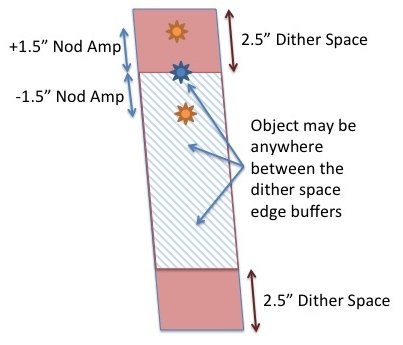
Below is information regarding mask design and the options for dithering along the slit. It is important to consider the dither options when setting mask design parameters.
The dither space is the buffer between the top and bottom edge of a slit where an object may not be placed. The default is 2.5 arcsec, but it can be any size you would like. For point-like sources, the default size is acceptable. The dither space limits the size of the nod amplitude you may choose to ensure good background subtraction during data reduction. You will likely set the nod amplitude large enough to adequately separate the nod positions to prevent overlap in the spectra. At the telescope, the default nod amplitude is listed in MAGMA as 1/2 the dither space, but this may not be optimal. An example is presented in the figure below describing a typical "mask nod" dither sequence.
A 2.5 dither space is defined during the mask design phase, and a nod amplitude of 1.5 arcsec is used during observing. This leaves 1 arcsec of space to the edge of the slit and 3 arcsec between the nod pairs.
The image below shows what could happen if a star is at the edge of the defined dither space and emphasizes why the nod amplitude set for spectroscopic observations must be smaller than the dither space defined in the design phase.

It's likely that your spectral exposures following the alignment images will see persistence, but it should subside quickly. For mor information on persistence see our persistence web documentation. Our recommended exposure times page lists the sky brightness for imaging mode, which may help you determine how much flux you'll see.
Image: Description: This is a two point dither pattern. The nod
amplitude is the +/- offset from the center
position. Typical nod amplitudes are 1-1.5 arcsec.
A sequence of images move ABABABAB. This
pattern is typically used when exposure times are
relatively long 1-3 min.
Image: Description: This is a two point dither pattern but the
pattern acquired two observations at the same
position before moving to the next object. Typical
nod amplitudes are 1-1.5 arcsec. The nod
amplitude is the +/- offset from the center
position. A sequence of images move ABBAABBAABBAABBA.
This pattern is typically used when acquiring
relatively bright objects such as standards where
observations are short relative to the time required
to offset the telescope (5-10 sec).
Image: Description: This is a four point dither pattern. Typical
nod amplitudes are 1.5 and 1.2 arcsec for the outer and
inner nod amplitudes, respectively. The nod
amplitude is the +/- offset from the center
position. A sequence of images move ABA'B'ABA'B'. This
pattern is typically used when exposure times are
relatively long 1-3 min. Observers who use this
pattern employ it because the literature suggests
an improvement in the signal-to-noise over a
simple AB dither pattern.
Image: Description: This is an N point dither pattern. The nod
amplitudes are set by the slit length and the
desired number of nods. The above image shows an
example of a 5 point dither pattern in a 7arcsec
long slit. This
pattern is typically used when exposure times are
relatively short with standard stars (5-10 sec). An
advantage is that the star does not land on the
same rows of pixels which can lead to
persistence issues.